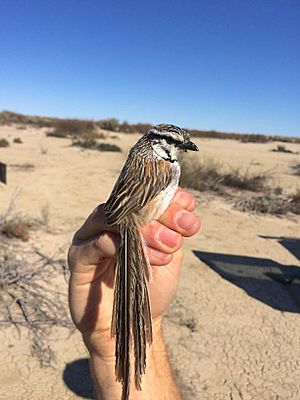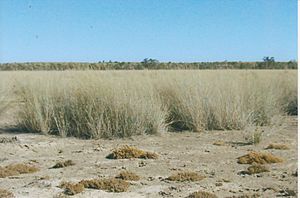Grey grasswren facts for kids
Quick facts for kids Grey grasswren |
|
|---|---|
 |
|
| Grey grasswren - Narriearra (north-western New South Wales) | |
| Conservation status | |
| Scientific classification | |
| Subspecies | |
|
See text |
The grey grasswren (Amytornis barbatus) is a small passerine bird, which means it's a type of perching bird. It belongs to the Australasian wren family, Maluridae. This bird lives only in Australia, specifically in the dry inland floodplains.
The grey grasswren is quite hard to spot. It was first seen in 1921 but wasn't officially named and described until 1968. You can tell it apart from other grasswrens by its grey color and very long tail. Scientists are still learning a lot about this shy bird and how it lives.
Contents
About the Grey Grasswren
The grey grasswren is part of the Maluridae family. This family includes five groups of birds found only in Australia and New Guinea.
Different Types of Grey Grasswrens
There are two recognized types, called subspecies:
- A. b. barbatus – This type was named by Favaloro and McEvey in 1968. It lives in the Bulloo River area, which is in south-western Queensland and north-western New South Wales, Australia.
- A. b. diamantina – This type was named by Schodde and Christidis in 1987. It is found near the Diamantina River in south-western Queensland and north-eastern South Australia.
What the Grey Grasswren Looks Like
The grey grasswren is a small bird, usually about 18 to 20 centimeters (7 to 8 inches) long. Its wingspan is around 21 cm (8 inches), and it weighs between 15 and 23 grams (about half an ounce).
Its main color is a ginger-brown with grey and off-white stripes. Its face has a black and white pattern. It has a broad white stripe above its eye (like an eyebrow). A black stripe runs from its beak through its eyes. This stripe connects to a thin black line around the sides of its throat.
Its tail is very long and narrow, with pointed feathers. The two middle tail feathers are longer than the ones next to them. Male and female grey grasswrens look the same in terms of the color of their sides or belly. Young birds are duller in color but look similar to adults. They don't have the distinct face pattern.
Scientists don't know much about when these birds change their feathers (molt). It's thought to happen once a year after they breed, usually between October and December.
What Sounds They Make
Scientists have described the grey grasswren's calls in different ways:
- Favaloro and McEvey said it makes a soft, two-part note that it tweets often.
- Joseph noted that calls were given constantly for several minutes. These were a series of three or four high-pitched, metallic notes, sounding like pit-choo.
- Carpenter described the call as a high-pitched sit-sit-sit.
Where They Live and Their Home
The grey grasswren lives in a specific area of dry inland floodplains in central Australia. They have been seen in places like the Bulloo Overflow near the New South Wales/Queensland border. They also live along the lower Cooper Creek and the Kallakoopah branch of the Diamantina River. Other sightings have been in the overflow areas of lakes Machattie, Koolivoo, and Mipea on Eyre Creek in South Australia.
These birds mostly live in floodplains that have lots of lignum and cane grass. These plants grow along major water channels between sand dunes. In some wet areas, you might find a thick layer of spike-rush, channel millet, and sedges.
Sometimes, grey grasswrens are found in open areas away from the lignum swamps. These areas don't flood as often. It seems that during dry years, the grey grasswren stays in tall, thick lignum for safety. In normal years, it prefers other types of homes. One researcher, Hardy, found more birds captured during drought years than in normal years.
In 2011, a big survey was done at Frome Swamp in New South Wales. This area had recently received a lot of rain, causing the lignum and cane grass to grow well. Even with many ways to find birds, like using nets and playing bird calls, no grey grasswrens were found. This might mean the birds move around a lot, which Hardy also noticed in his earlier surveys.
How the Grey Grasswren Lives
Reproduction and Life Cycle
Scientists don't know a lot about how these birds breed. It's thought they breed in July or August, usually after floods or heavy rain. However, Hardy saw them breeding during a severe drought, even when there had been no surface water in the area for at least seven years.
Their nest is shaped like a half-dome and is built in lignum or cane grass. It's usually 30 to 75 centimeters (1 to 2.5 feet) above the ground. Favaloro and McEvey noted that the nest was large and well-hidden. It was loosely made from grass with a big opening on the side.
They usually lay two eggs, each weighing about 2.4 grams. The eggs are dull white with nutmeg brown, reddish-brown, or cinnamon brown spots all over. The colors can vary a lot between eggs in the same nest and between different nests.
Only the female bird sits on the eggs to keep them warm. This takes about 13 to 15 days. Both parents help feed the baby birds after they hatch. We don't know much about how many of their young survive.
What They Eat
The shape of the grey grasswren's beak suggests it mainly eats seeds. When scientists looked at the stomach contents of one bird, they found mostly small seeds from different plants. They also found two small ants and parts of small beetles. However, other researchers have noted that insect larvae are the main food source. They also eat adult insects and water snails.
How Long They Live and How Many There Are
We don't know much about how long grey grasswrens live. But research in one of their main lignum homes found that some birds lived for at least three years in that area.
The number of grey grasswrens can change a lot. It depends on the weather in their dry inland home. During droughts, their numbers might drop, and after good rains, they might increase. Based on a survey during drought conditions, the population in New South Wales was estimated to be about 1,600 birds. This means about 0.2 birds per hectare. However, it's hard to guess the total Australian population because their habitat and the seasons change so much.
Protecting the Grey Grasswren
The grey grasswren is listed as a threatened species under Australia's national Environment Protection and Biodiversity Conservation Act 1999. It is also listed as endangered in New South Wales under the Biodiversity Conservation Act 2016 and in Queensland under the Nature Conservation Act 1992. In South Australia, the National Parks and Wildlife Act 1972 lists it as rare. However, the IUCN Red List says it is a species of least concern, meaning it's not currently at high risk of extinction globally.
Protecting Them for the Future
Not much research has been done on the grey grasswren, especially recently. Since it lives in very specific places, its main threats are:
- Habitat damage: This happens when too many cattle, rabbits, and wild pigs eat and stomp on the plants where the birds live.
- Predators: Cats can hunt these birds.
- Invasive weeds: These plants can take over the birds' habitat.
- Natural events: Because they rely on lignum and similar plants, they are at risk from big events like droughts and fires.
- Climate change: The effects of climate change also need to be studied more to make sure the grey grasswren can keep living in Australia's dry regions. This means protecting suitable areas for them.
New Conservation Area
In June 2020, the Government of New South Wales bought a huge piece of private land for a new national park. It was 153,415 hectares (about 1,534 square kilometers or 592 square miles). This land, called Narriearra station, is in the far north-west of the state.
This area includes wetlands and landscapes that dry up and fill with water. These types of areas had not been protected in the state's conservation areas before. With the nearby Sturt National Park, there will be a huge protected area of about 500,000 hectares (about 1,930 square miles). This is twice the size of the Australian Capital Territory.
The new park is next to the Pindera Downs Aboriginal area, which has many important cultural items from Aboriginal Australians. This land purchase was the largest ever for conservation in New South Wales. The Dingo Fence on the border with Queensland forms the northern edge of the property.
Almost 90 percent of the grey grasswren's habitat is within Narriearra Station. So, this new park is a very important step in protecting this special bird. The Tibooburra Local Aboriginal Land Council has been asked to suggest a name for the new park.
See also
 In Spanish: Maluro gris para niños
In Spanish: Maluro gris para niños



